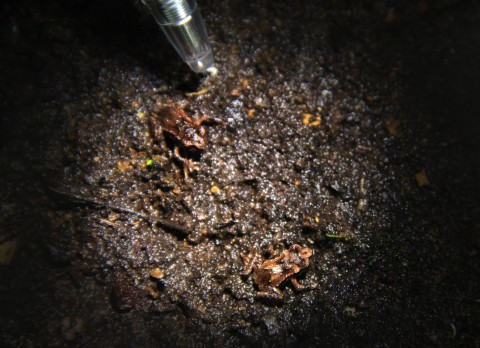Breeding breakthrough for critically endangered frog
Frogs typically make good captive breeders, so the fact that for eight years experts couldn’t successfully raise one froglet from our Archey’s frog was proving mind-bogglingly frustrating.
Enter Richard Gibson – an English reptile and amphibian breeding expert with over 20 years of experience.
He flew here in late 2011 to take up a position as the Team leader of Reptiles and Invertebrates at Auckland Zoo, and one of the defining challenges of that role was to get this tiny 50 million year old frog to breed successfully.
After touchdown he immediately began tweaking husbandry methods in the hope of producing froglets from this critically endangered frog, and in December last year seven froglets were hatched (our frogs don’t have a free-swimming tadpole stage).
Three months on and the biggest challenge is providing these minute frogs with enough midget-sized meals of new-born slaters and springtails to provide them with sustenance. And to ensure the frogs diet is top-notch they feed these midget creatures a special formula!
Unfortunately the parents of these froglets are unknown because the frogs had an unscheduled love-fest before keepers could separate the 24 frogs into pairs. Gibson describes it as an ‘amphibian Roman-style orgy’. Legs, arms, more legs – and eggs. You get the picture.
So although the keepers are delighted about the arrival of these little wonders, they’re scratching their heads as to which ones are the successful breeders. Despite this, they’re pretty chuffed at the results, which Gibson puts down to two elements: diet and environment.
Frogs as a rule live a pretty inactive lifestyle and zoo-life proved especially easy, so many of the frogs had grown over-weight which may have affected fertility.. So by slimming them down, drying them out a little and creating some seasonal variation in their environment, the essential ingredients were in place, and voila!
These pea-sized frogs are taking up a mere 1% of space in their special breeding facility, so there’s room for plenty more frogs. However, it’s only once a second generation of Archey’s are born that Gibson will consider that the husbandry is truly cracked and breeding Archey’s frog is a done-deal.
In the meantime he is considering the possibility of working with threatened Hochstetter’s and endangered Hamilton’s and Maud island frogs to help understand their biology and master their husbandry too.
Richard says at this stage, learning about the Archey’s frog diet, habits and specific environmental requirements is a priority. And with this knowledge they’ll be in a better position to undertake large-scale conservation-breeding programme should things deteriorate further in the wild. For now though, staff at Auckland Zoo are busy finessing a special enclosure and selecting the frogs, for a new display in Tae Wao Nui’s Night Forest – the first ever for this little known jewel of the New Zealand forests.

